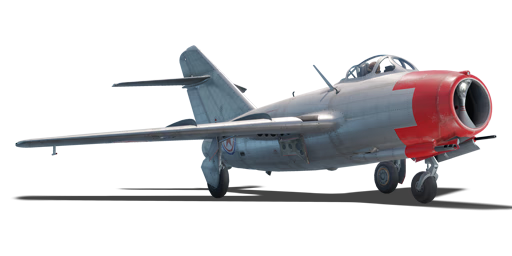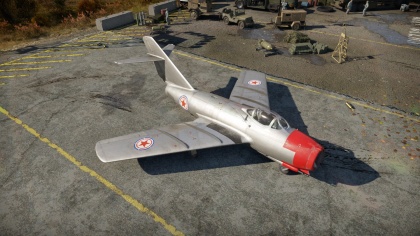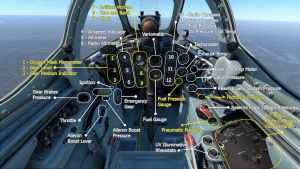MiG-15
Contents
| This page is about the Russian jet fighter MiG-15. For other uses, see MiG-15 (Family). |
Description
The MiG-15 is a Rank V Russian jet fighter
with a battle rating of 8.7 (AB), 8.0 (RB), and 8.3 (SB). This aircraft was introduced in Update 1.35. The main differences between this aircraft and the MiG-15 bis are weaker engine performance and NR-23 23 mm autocannons.
General info
Flight Performance
The MiG-15 has excellent acceleration, climb rate, and energy retention. However, this comes at the cost of extremely high compression at subsonic speeds and a near nonexistent roll rate, as well as underwhelming turn at high speeds.
| Characteristics | Max Speed (km/h at 0 m - sea level) |
Max altitude (metres) |
Turn time (seconds) |
Rate of climb (metres/second) |
Take-off run (metres) | |||
|---|---|---|---|---|---|---|---|---|
| AB | RB | AB | RB | AB | RB | |||
| Stock | 1,009 | 975 | 15500 | 22.4 | 23.7 | 34.2 | 32.5 | 600 |
| Upgraded | 1,067 | 1,050 | 22.8 | 22.1 | 50.8 | 42.0 | ||
Details
| Features | |||||
|---|---|---|---|---|---|
| Combat flaps | Take-off flaps | Landing flaps | Air brakes | Arrestor gear | Drogue chute |
| X | ✓ | ✓ | ✓ | X | X |
| Limits | ||||||
|---|---|---|---|---|---|---|
| Wings (km/h) | Gear (km/h) | Flaps (km/h) | Max Static G | |||
| Combat | Take-off | Landing | + | - | ||
| 0 | 450 | N/A | 650 | 450 | ~12.5 | ~5 |
| Optimal velocities (km/h) | |||
|---|---|---|---|
| Ailerons | Rudder | Elevators | Radiator |
| < 600 | < 700 | < 750 | N/A |
Engine performance
| Engine | Aircraft mass | ||||||
|---|---|---|---|---|---|---|---|
| Engine name | Number | Empty mass | Wing loading (full fuel) | ||||
| Klimov RD-45F | 1 | 3,508 kg | 229 kg/m2 | ||||
| Engine characteristics | Mass with fuel (no weapons load) | Max Takeoff Weight | |||||
| Weight (each) | Type | 10m fuel | 20m fuel | 30m fuel | 33m fuel | ||
| 872 kg | Centrifugal-flow turbojet | 3,875 kg | 4,241 kg | 4,608 kg | 4,718 kg | 5,485 kg | |
| Maximum engine thrust @ 0 m (RB / SB) | Thrust to weight ratio @ 0 m (100%) | ||||||
| Condition | 100% | WEP | 10m fuel | 20m fuel | 30m fuel | 33m fuel | MTOW |
| Stationary | 2,086 kgf | N/A | 0.54 | 0.49 | 0.45 | 0.44 | 0.38 |
| Optimal | 2,086 kgf (0 km/h) |
N/A | 0.54 | 0.49 | 0.45 | 0.44 | 0.38 |
Survivability and armour
- 64 mm Bulletproof glass in the cockpit front
- 10 mm Steel plate in front of the pilot in the nose
- 6 mm Steel plate in pilot's seat
- 10 mm Steel plate behind the pilot's head
Armaments
Offensive armament
The MiG-15 is armed with:
- 1 x 37 mm N-37D Cannon, nose mounted (40 RPG = 40 total)
- 2 x 23 mm NS-23 Cannon, nose mounted (80 RPG = 160 total)
Both the N-37 and the NS-23 cannons have the muzzle velocity of 690 m/s.
Suspended armament
The MiG-15 can be outfitted with the following ordinance:
- Without load
- 2 x 100 kg FAB-100 bombs (200 kg = total)
- 2 x 250 kg FAB-250M43 bombs (500 kg = total)
Usage in battles
At higher ranks of the Soviet aviation line, the MiG-15 series is one of the most iconic jet fighter aircraft designs from after the Second World War. Earning its reputation on fame over the skies of Korea against its US contemporary, the F-86 Sabre.
The MiG-15 can be researched from its predecessor, the MiG-9/L. The MiG-15 features a powerful cannon arrangement of 2 x 23 mm and 1x 37 mm, excellent high altitude performance and is highly effective in vertical manoeuvres. Unlike the MiG-9, the MiG-15 is also the first Soviet jet aircraft to feature an air brake which is extremely useful in combat situations. The jet fighter does, however, have its downsides. The lack of an “All-flying tailplane” (such as that featured on the Sabre) leads to less control over the aircraft at higher speeds approaching 1,000 kph. While the MiG is initially faster in acceleration by comparison to the Sabre, this does mean that once both aircraft are up at higher speeds, the Sabre will hold some advantages over the MiG-15. It should be noted that if you load 8 minutes of fuel instead of the regular (for most pilots) 20, it drastically improves your performance. However, this is not recommended to be done at the beginning of the match as most matches last longer than 8 minutes, and should instead be done when you land mid-match.
The combination of 37 mm and 23 mm cannons creates aiming issues for pilots not familiar with their ballistic properties or velocity. Due to the size of these cannons, ammunition pools are restricted by comparison to other top tier jet aircraft. To help compensate the two different trajectories of the armament, it is recommended to use 'rolling' manoeuvres, as the rudder may lock in high speeds. To aim with these cannons, it is best to estimate the lead with the experience built up with planes beforehand (ie.: Yak-9T / La-9) and add extra distance over the estimated lead (about double from the estimated).
Once pilots have learned to use the MiG-15s excellent rate of climb, acceleration and high altitude capabilities to their advantage, the downsides of the aircraft are far less significant than the positives. In the right hands, the MiG-15 can be a devastating combatant, capable of dealing with any aircraft in game swiftly. Teamwork, Squads and communication will also be beneficial when flying the MiG-15 as effective coordination between multiple pilots allow you to use this aircraft to its maximum potential. After mastering the MiG-15, you can research its improved variant, the MiG-15Bis. As the MiG-15 is essentially a slightly merged MiG-15bis, it shares much of its performance issues and abilities.
Manual Engine Control
| MEC elements | ||||||
|---|---|---|---|---|---|---|
| Mixer | Pitch | Radiator | Supercharger | Turbocharger | ||
| Oil | Water | Type | ||||
| Not controllable | Not controllable | Not controllable | Not controllable | Separate | Not controllable | Not controllable |
Modules
| Tier | Flight performance | Survivability | Weaponry | ||
|---|---|---|---|---|---|
| I | Fuselage Repair | Compressor | Offensive 23 mm | ||
| II | Airframe | New 23 mm Cannons | |||
| III | Wings Repair | Offensive 37 mm | BD-2-48 | ||
| IV | Engine | Cover | New 37 mm Cannons | ||
Pros and cons
Pros:
- Flaps can be deployed at high speeds
- Capable and useful air brake
- High rate of climb
- Great acceleration
- Deadly armament capable of making snapshots
- Excellent energy retention
Cons:
- Abysmal roll rate
- Poor turning circle
- Compression at high speeds
- Extremely challenging to use when stock
- Armament difficult to use (low velocities, low ammo and two different trajectories)
- Guns tend to spark a lot (the N-37 in particular)
- No G-suit, so maintaining control is difficult when turning at high speeds
- No S-21 rockets
History
First taking to the air in December of 1947, the Mikoyan-Gurevich MiG-15 jet fighter aircraft came as a massive shock to the west when it appeared in the skies over Korea in the early 1950s. The swept-wing fighter quickly proved itself as a capable and effective combat aircraft and forged a fearsome reputation.
The prototype I-310 was designed around the British Rolls Royce Nene engine which was purchased under license from Great Britain as the RD-45. Featuring sleek swept-back wings, tricycle undercarriage and the same armament as its predecessor, the MiG-9, in the form of 2 x 23mm NS-23 cannons (Later replaced by NR-23 cannons in the MiG-15Bis model) and a single 37mm N-37D cannon all mounted centrally under the nose intake. The new aircraft was designed as an interceptor with heavy armament capable of quickly taking out bomber formations and was one of the most advanced aircraft in the world at the time.
Entering service between 1949-50, the MiG-15 made its operational combat debut in the Korean War, completely outclassing the first-generation jet fighter aircraft of the UN forces such as the F-80 and F-84. The MiG’s excellent rate of climb, high-speed performance and deadly weaponry proved superior to the early jets and was only challenged by the arrival of the North American F-86 Sabre. At the time, the Sabre was the only aircraft capable of effectively combating the MiG in aerial combat and the pair became synonymous with the conflict.
From 1950, the MiG-15 was later developed into the Bis model, featuring a new engine, armament changes and minor overall improvements. However, the aircraft would ultimately lead to the development of the MiG-17. The MiG-15 was also a hugely successful export aircraft, operated by many nations such as Poland, Czechoslovakia, East Germany, China, North Korea and Vietnam to name but a few. Licence built versions of the MiG-15 also existed such as the Chinese J-2, Czech S-102/3 and Polish Lim-1.
The MiG-15 is a true icon of aviation and will provide experienced pilots with an impressive top tier jet fighter when employed to its strengths, being more than a match to any other aircraft in the game.
In-game description
"A single-seat all-metal cantilever monoplane fighter. Continuing the line of the La-5/La-7 fighters, the designers of the Lavochkin Design Bureau wanted to remove all of the wood from the aircraft's construction and create an all-metal fighter. In early 1946, prototype fighter 130 was built, to be launched into full-scale production under the designation of La-9 (Product 48) after the tests had been passed.
The La-9 was a new plane, not just an upgrade of the La-7 with metal parts instead of wooden ones. The La-9 had differently shaped monospar wings with laminar flow airfoils. This plane did not have leading edge slats. The weight savings gained by replacing wood with duralumin enabled the designers to mount five fuel tanks on the aircraft and increase the total fuel capacity.
The La-9's cockpit was more spacious than the La-7's, and its canopy required less framing and provided better visibility. By pressurizing the cockpit and the power unit compartment, one of the main shortcomings of the Lavochkins - the high temperature in the pilot's cockpit during engine operation - was finally overcome. Also, the aircraft's instrumentation system was brought into line with worldwide standards. A radio compass, an attitude indicator, and an identification-friend-or-foe transponder enabled the aircraft to be piloted and engage in dogfights even in difficult weather conditions.
The La-9 had a Shvetsov ASh-82FN fourteen-cylinder two-row radial air-cooled fuel-injected engine producing a maximum power of 1,850 hp. The plane's armament consisted of four synchronous 23mm Nudelman-Suranov NS-23S cannons with 300 rounds each. A Fairchild gun camera mounted on the right wing panel was used to direct shooting and for training purposes. Later it was replaced with an S-13, its Soviet counterpart, which was placed in the fairing over the cockpit windshield.
Production of the La-9 continued until 1949. A total of 1,882 planes were manufactured. Troops in the Soviet Air Force began to receive the new fighters in 1947. The La-9 did not remain in service for long, since the Air Force quickly switched to jet technology. The early 1950s saw the beginning of the mass handover of piston fighters for warehousing and conservation, as well as the re-equipping of fighting troops with MiG-15 jet aircraft.
In addition to flying with the Soviet Air Force, La-9 fighters remained in service with the People's Liberation Army Air Force of China until 1959, laying the foundation for the new Chinese Air Force. When the Korean War began, the La-9 was being supplied to the North Korean Air Force. The first planes were received in September and October 1950. During the final stage of the war, the Koreans used the La-9s as light night bombers. When bomb racks were mounted, the fighter could carry two 50-kg bombs. After the war, La-9s were in service with the Korean People's Army Air Force until the end of the 50s."
Media
An excellent addition to the article will be video guides, as well as screenshots from the game and photos.
See also
Links to the articles on the War Thunder Wiki that you think will be useful for the reader, for example:
- reference to the series of the aircraft;
- links to approximate analogues of other nations and research trees.
External links
| Mikoyan-Gurevich Design Bureau (Микоя́н и Гуре́вич Опытное конструкторское бюро) | |
|---|---|
| Fighters | MiG-3-15 · MiG-3-15 (BK) · MiG-3-34 |
| I-225 | |
| Jet fighters | MiG-9 · MiG-9 (l) |
| MiG-15 · MiG-15bis · MiG-15bis ISh | |
| MiG-17 | |
| MiG-19PT | |
| MiG-21F-13 · MiG-21PFM · MiG-21S (R-13-300) · MiG-21SMT · MiG-21bis | |
| MiG-23M · MiG-23ML · MiG-23MLD | |
| MiG-27M · MiG-27K | |
| MiG-29 · MiG-29SMT | |
| Export/Licensed | ␗MiG-9 · ␗MiG-9 (l) |
| ◊MiG-15bis · ◔MiG-15bis · J-2* | |
| MiG-17AS · ◔MiG-17PF · J-4* · Shenyang F-5* | |
| ◊MiG-19S · J-6A* | |
| ◄MiG-21 SPS-K · ◊MiG-21MF · ◔MiG-21MF · ▄MiG-21bis · ◔MiG-21bis-SAU · ◊MiG-21bis-SAU · ◊MiG-21 "Lazur-M" · ▄MiG-21 Bison · J-7II** | |
| ◊MiG-23BN · ◊MiG-23MF · ◔MiG-23MF · ◊MiG-23MLA | |
| ◔MiG-29 · ◊MiG-29 · ◄MiG-29G | |
| *Licensed and domesticated with Chinese designations. | |
| **Unlicensed, reverse-engineered and domesticated with Chinese designations. | |
| See Also | Shenyang · Chengdu |
| USSR jet aircraft | |
|---|---|
| Bereznyak-Isayev | BI |
| Yakovlev | Yak-15 · Yak-15P · Yak-17 · Yak-23 · Yak-28B · Yak-30D · Yak-38 · Yak-38M · Yak-141 |
| Mikoyan-Gurevich | MiG-9 · MiG-9 (l) · MiG-15 · MiG-15bis · MiG-15bis ISh · MiG-17 · MiG-17AS · MiG-19PT |
| MiG-21F-13 · MiG-21PFM · MiG-21S (R-13-300) · MiG-21SMT · MiG-21bis | |
| MiG-23M · MiG-23ML · MiG-23MLD · MiG-27M · MiG-27K | |
| MiG-29 · MiG-29SMT | |
| Lavochkin | La-174 · La-15 · La-200 |
| Sukhoi | Su-9 · Su-11 |
| Su-7B · Su-7BKL · Su-7BMK · Su-17M2 · Su-17M4 · Su-22M3 | |
| Su-24M | |
| Su-25 · Su-25BM · Su-25K · Su-25T · Su-25SM3 · Su-39 | |
| Su-27 · Su-27SM | |
| Su-34 | |
| Ilyushin | IL-28 · IL-28Sh |
| Tupolev | Tu-14T |






